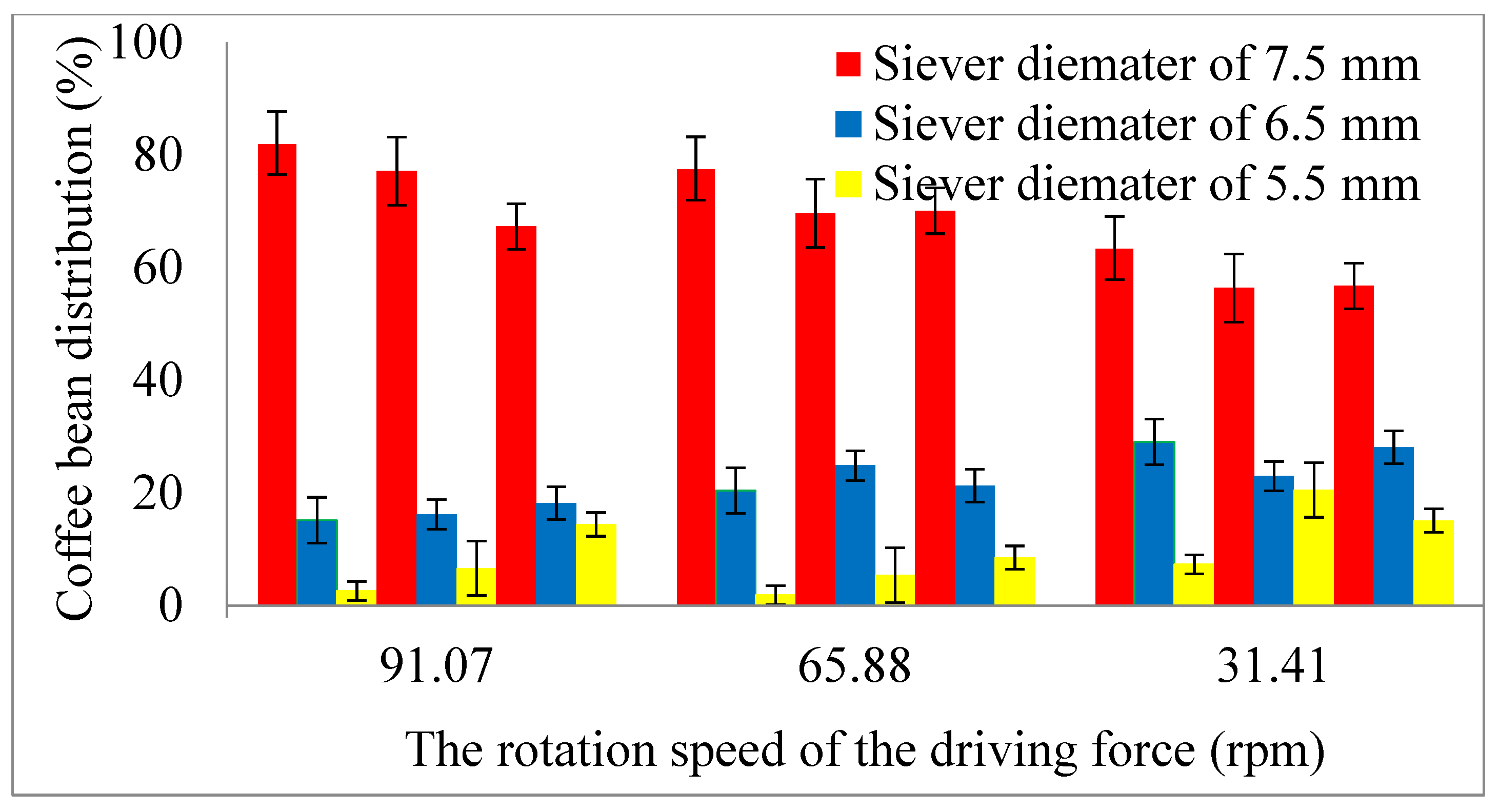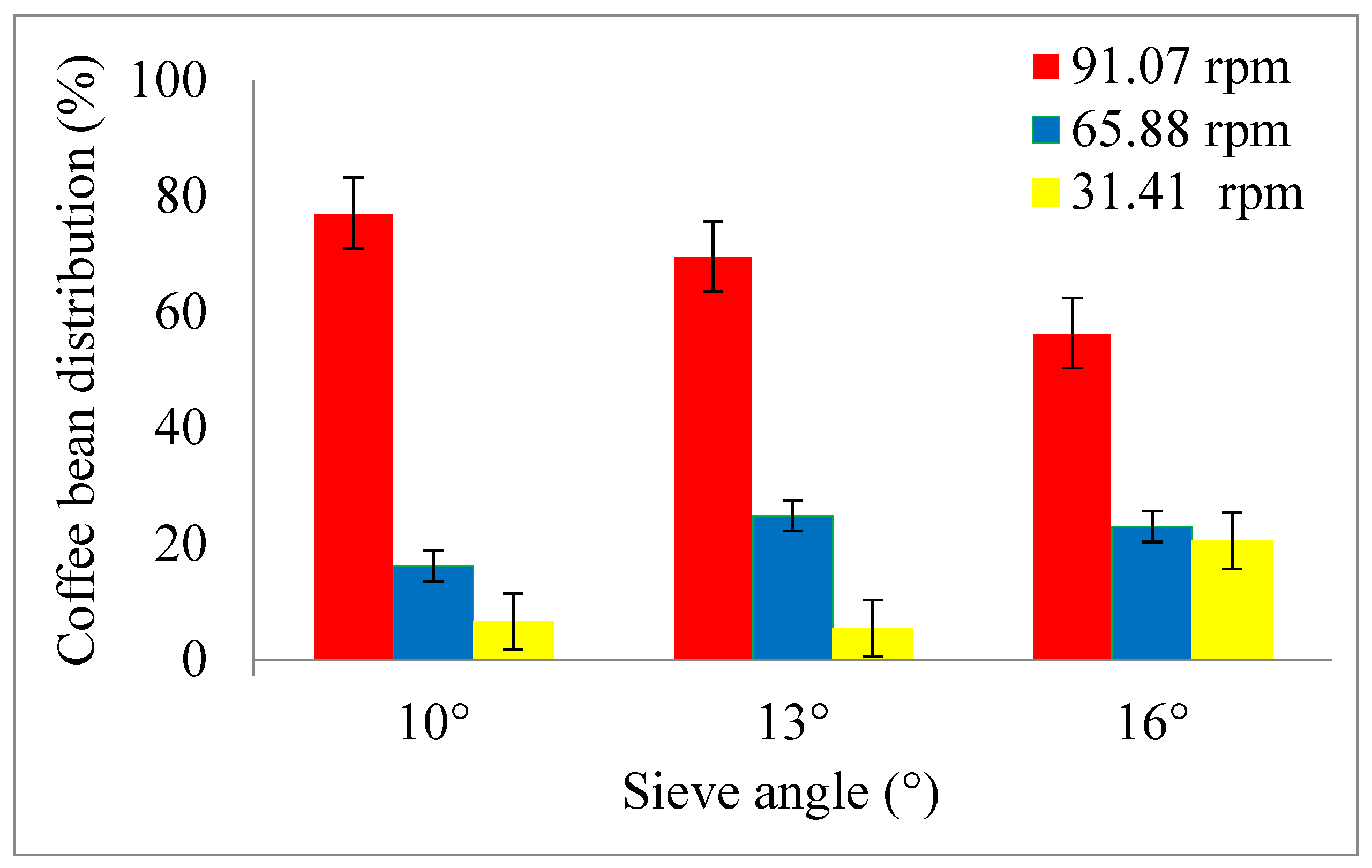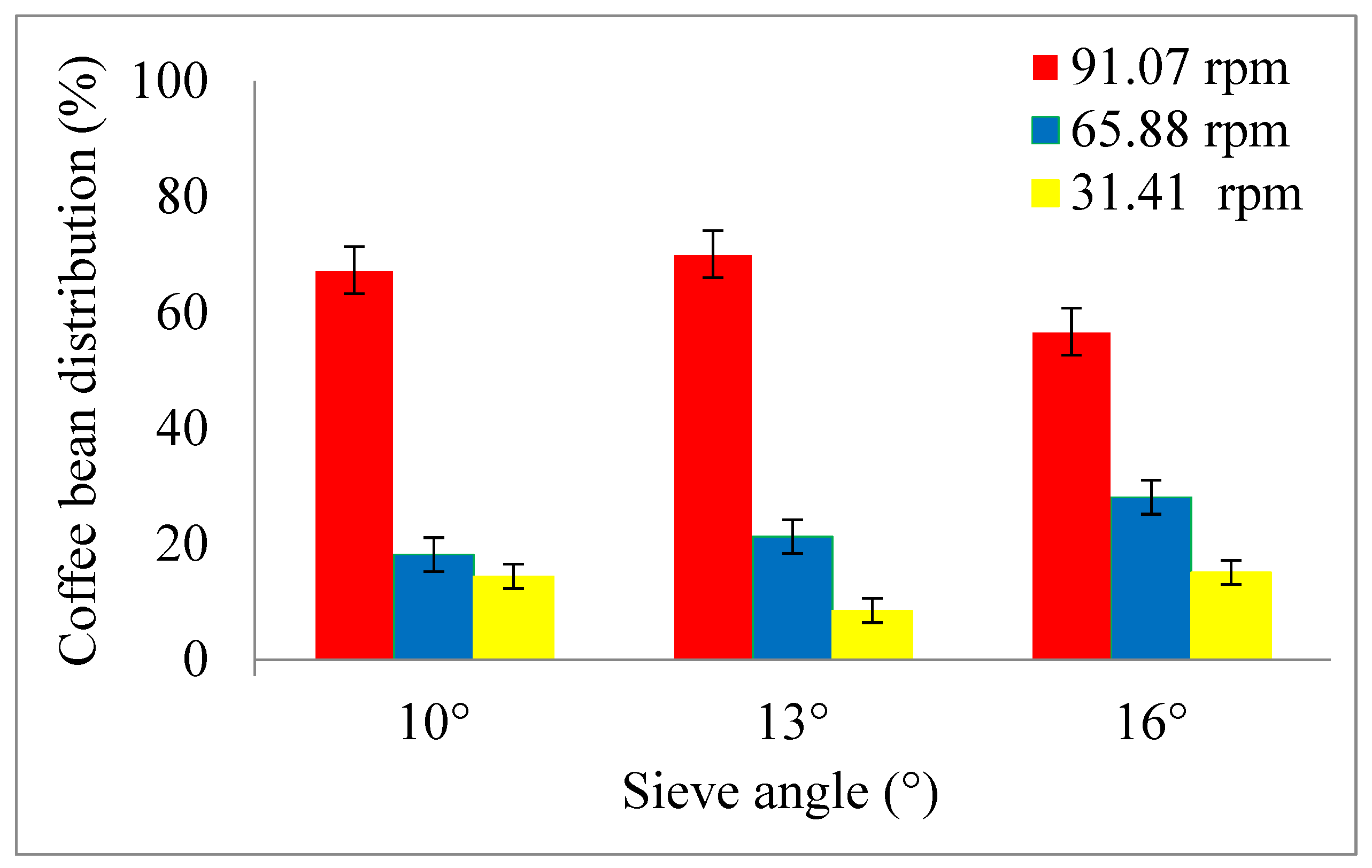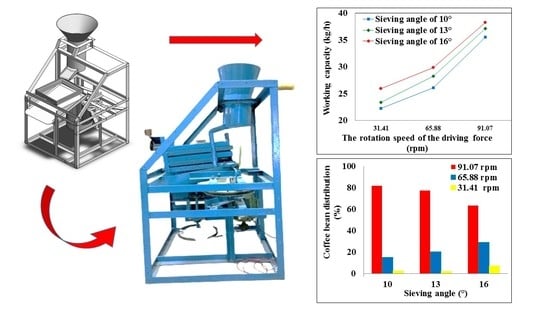Design and Performance Test of the Coffee Bean Classifier
Abstract
:1. Introduction
2. Materials and Methods
2.1. Material and Tools
- Feed hopper
- Frame
- Output hopper
- Classification chamber
- Output
- Electric motor drive
- Pulley
- V-belt
2.2. Research Procedure
2.3. Research Parameters
2.4. Data Analysis
3. Results and Discussion
3.1. Classifier Working Capacity
3.2. Power
R2 = 0.9559
3.3. Specific Energy Consumption
3.4. Distribution of Classification Results
3.5. Classification Electivity
3.5.1. The First Sieve
3.5.2. The Second Sieve
3.5.3. The Third Sieve
3.5.4. The Efficiency of Classification
4. Conclusions
Author Contributions
Funding
Institutional Review Board Statement
Informed Consent Statement
Data Availability Statement
Acknowledgments
Conflicts of Interest
References
- Monteiro, P.I.; Santos, J.S.; Brizola, V.A.; Deolindo, C.P.; Koot, A.; Boerrigter-Eenling, R.; van Ruth, S.; Georgouli, K.; Koidis, A.; Granato, D. Comparison between proton transfer reaction mass spectrometry and near infrared spectroscopy for the authentication of Brazilian coffee: A preliminary chemometric study. Food Control 2019, 91, 276–283. [Google Scholar] [CrossRef]
- Grgic, J.; Grgic, I.; Pickering, C.; Schoenfeld, B.J.; Bishop, D.J.; Pedisic, Z. Wake up and smell the coffee: Caffeine supplementation and exercise performance-an umbrella review of 21 published meta-analyses. Br. J. Sports Med. 2020, 54, 681–688. [Google Scholar] [CrossRef]
- Gokcen, B.B.; Sanlier, N. Coffee consumption and disease correlations. Crit. Rev. Food Sci. Nutr. 2019, 59, 336–348. [Google Scholar] [CrossRef]
- Gu, J.; Pei, W.; Tang, S.; Yan, F.; Peng, Z.; Huang, C.; Yang, J.; Yong, Q. Procuring biologically active galactomannans from spent coffee ground (SCG) by autohydrolysis and enzymatic hydrolysis. Int. J. Biol. Macromol. 2020, 149, 572–580. [Google Scholar] [CrossRef]
- Rodriguez, L.J.; Fabbri, S.; Orrego, C.E.; Owsianiak, M. Comparative life cycle assessment of coffee jar lids made from biocomposites containing poly(lactic acid) and banana fiber. J. Environ. Manag. 2020, 266, 110493. [Google Scholar] [CrossRef]
- Sanlier, N.; Atik, A.; Atik, I. Consumption of green coffee and the risk of chronic diseases. Crit. Rev. Food Sci. Nutr. 2019, 59, 2573–2585. [Google Scholar] [CrossRef]
- Krol, K.; Gantner, M.; Tatarak, A.; Hallmann, E. The content of polyphenols in coffee beans as roasting, origin and storage effect. Eur. Food Res. Technol. 2020, 246, 33–39. [Google Scholar] [CrossRef] [Green Version]
- Geeraert, L.; Berecha, G.; Honnay, O.; Aerts, R. Organoleptic quality of Ethiopian Arabica coffee deteriorates with increasing intensity of coffee forest management. J. Environ. Manag. 2019, 231, 282–288. [Google Scholar] [CrossRef]
- Kim, M.S.; Min, H.G.; Koo, N.; Park, J.; Lee, S.H.; Bak, G.I.; Kim, J.G. The effectiveness of spent coffee grounds and its biochar on the amelioration of heavy metals-contaminated water and soil using chemical and biological assessments. J. Environ. Manag. 2014, 146, 124–130. [Google Scholar] [CrossRef]
- Rossmann, M.; Matos, A.T.; Abreu, E.C.; Silva, F.F.; Borges, A.C. Effect of influent aeration on removal of organic matter from coffee processing wastewater in constructed wetlands. J. Environ. Manag. 2013, 128, 912–919. [Google Scholar] [CrossRef]
- Subedi, R.N. Comparative analysis of dry and wet processing of coffee with respect to quality and cost in Kavre District, Nepal: A case of Panchkhal Village. Int. Res. J. Appl. Basic Sci. 2011, 2, 181–193. [Google Scholar]
- Takahashi, R.; Todo, Y. The impact of a shade coffee certification program on forest conservation: A case study from a wild coffee forest in Ethiopia. J. Environ. Manag. 2013, 130, 48–54. [Google Scholar] [CrossRef] [Green Version]
- Odzakovic, B.; Dzinic, N.; Kukric, Z.; Grujic, S. Effect of roasting degree on the antioxidant activity of different Arabica coffee quality classes. Acta Sci. Pol. Technol. Aliment. 2016, 15, 409–417. [Google Scholar] [CrossRef] [Green Version]
- Ibarra-Taquez, H.N.; GilPavas, E.; Blatchley, E.R.; Gomez-Garcia, M.A.; Dobrosz-Gomez, I. Integrated electrocoagulation-electrooxidation process for the treatment of soluble coffee effluent: Optimization of COD degradation and operation time analysis. J. Environ. Manag. 2017, 200, 530–538. [Google Scholar] [CrossRef] [PubMed]
- Giraudo, A.; Grassi, S.; Savorani, F.; Gavoci, G.; Casiraghi, E.; Geobaldo, F. Determination of the geographical origin of green coffee beans using NIR spectroscopy and multivariate data analysis. Food Control 2019, 99, 137–145. [Google Scholar] [CrossRef] [Green Version]
- Cheng, B.; Furtado, A.; Smyth, H.E.; Henry, R.J. Influence of genotype and environment on coffee quality. Trends Food Sci. Technol. 2016, 57, 20–30. [Google Scholar] [CrossRef] [Green Version]
- Alara, O.R.; Abdurahman, N.H.; Ukaegbu, C.I. Extraction of phenolic compounds: A review. Curr. Res. Food Sci. 2021, 4, 200–214. [Google Scholar] [CrossRef]
- Yuksel, A.N.; Barut, K.T.O.; Bayram, M. The effects of roasting, milling, brewing and storage processes on the physicochemical properties of Turkish coffee. LWT Food Sci. Technol. 2020, 131, 109711. [Google Scholar] [CrossRef]
- Artavia, G.; Cortés-Herrera, C.; Granados-Chinchilla, F. Total and resistant starch from foodstuff for animal and human consumption in Costa Rica. Curr. Res. Food Sci. 2020, 3, 275–283. [Google Scholar] [CrossRef]
- Vogt, M.B. Developing stronger association between market value of coffee and functional biodiversity. J. Environ. Manag. 2020, 269, 110777. [Google Scholar] [CrossRef] [PubMed]
- Gunathilake, D.C.; Wasala, W.B.; Palipane, K.B. Design, development and evaluation of a size grading machine for onion. Procedia Food Sci. 2016, 6, 103–107. [Google Scholar] [CrossRef] [Green Version]
- Zhu, L.; Spachos, P.; Pensini, E.; Plataniotis, K.N. Deep learning and machine vision for food processing: A survey. Curr. Res. Food Sci. 2021, 4, 233–249. [Google Scholar] [CrossRef]
- Badmos, S.; Fu, M.; Granato, D.; Kuhnert, N. Classification of Brazilian roasted coffees from different geographical origins and farming practices based on chlorogenic acid profiles. Food Res. Int. 2020, 134, 109218. [Google Scholar] [CrossRef]
- Hernandez-Aguilera, J.N.; Gomez, M.I.; Rodewald, A.D.; Rueda, X.; Anunu, C.; Bennett, R.; van Es, H.M. Quality as a driver of sustainable agricultural value chains: The case of the relationship coffee model. Bus. Strategy Environ. 2018, 27, 179–198. [Google Scholar] [CrossRef]
- Adhikari, J.; Chambers, E.; Koppel, K. Impact of consumption temperature on sensory properties of hot brewed coffee. Food Res. Int. 2019, 115, 95–104. [Google Scholar] [CrossRef] [PubMed]
- Feria-Morales, A.M. Examining the case of green coffee to illustrate the limitations of grading systems/expert tasters in sensory evaluation for quality control. Food Qual. Prefer. 2002, 13, 355–367. [Google Scholar] [CrossRef]
- Arboleda, E.R. Comparing Performances of Data Mining Algorithms for Classification of Green Coffee Beans. Int. J. Eng. Adv. Technol. 2019, 8, 1563–1567. [Google Scholar]
- Srisang, N.; Chanpaka, W.; Chungcharoen, T. The performance of size grading machine of robusta green coffee bean using oscillating sieve with swing along width direction. In IOP Conference Series: Earth and Environmental Science; IOP Publishing: Bristol, UK, 2019. [Google Scholar]
- Widyotomo, S. Optimation of a table conveyor type grading machine to increase the performance of green coffee manual sortation. Coffee Cocoa Res. J. 2006, 22. [Google Scholar] [CrossRef]
- Ola, D.; Manescu, M.; Cristea, L.; Budde, J.; Hoffmann, T. Software application in machine vision investigation of agricultural seeds quality. Appl. Mech. Mater. 2013, 436, 463–473. [Google Scholar] [CrossRef]
- Portugal-Zambrano, C.E.; Gutiérrez-Cáceres, J.C.; Ramirez-Ticona, J.; Beltran-Castañón, C.A. Computer vision grading system for physical quality evaluation of green coffee beans. In Proceedings of the 2016 XLII Latin American Computing Conference (CLEI), Valparaiso, Chile, 10–14 October 2016. [Google Scholar]
- Chanpaka, W.; Srisang, N.; Dangwilailux, P.; Chungcharoen, T. The Increase of efficiency in robusta green coffee bean size sorting machine by Response Surface Methodology. In Journal of Physics: Conference Series; IOP Publishing: Bristol, UK, 2020. [Google Scholar]
- Li, L.; Hu, R.; Li, L.; Yuan, Z.; Sun, S.; Jiang, X.; Gu, R.; Wang, J. Physical character-based grading of maize seeds. Seed Sci. Technol. 2019, 47, 281–299. [Google Scholar] [CrossRef]
- Chau, M.Q.; Nguyen, V.T. Effects of frequency and mass of eccentric balls on picking force of the coffee fruit for the as-fabricated harvesting machines. Int. J. Adv. Sci. Eng. Inf. Technol. 2019, 9, 1039–1045. [Google Scholar] [CrossRef] [Green Version]
- Kumar, V.; Rajak, D.; Kumar, R.; Kumar, V.; Sharma, P.D. Design and development of low-cost makhana grading and roasting machine. Int. J. Food Eng. 2014, 10, 357–366. [Google Scholar] [CrossRef]
- Ansar, S.; Abdullah, S.H.; Safitri, E. Physical and chemical properties of mixture fuels (MF) between palm sap (arenga pinnata merr) bioethanol and premium. ACS Omega 2020, 75, 1–9. [Google Scholar]
- Mofolasayo, A.; Adewumi, B.; Ajisegiri, E.; Agboola, A. Review of the aerodynamics and particle dynamics for coffee separation. LAUTECH J. Eng. Technol. 2018, 12, 16–20. [Google Scholar]
- Olukunle, O.J.; Akinnuli, B.O. Investigating some engineering properties of coffee seeds and beans. J. Emerg. Trends Eng. Appl. Sci. 2012, 3, 743–747. [Google Scholar]
- Qian, J.; Li, J.; Sun, F.; Xiong, J.; Zhang, F.; Lin, X. An analytical model to optimize rotation speed and travel speed of friction stir welding for defect-free joints. Scr. Mater. 2013, 68, 175–178. [Google Scholar] [CrossRef]
- Konstantinos, S.; Peter, B. Energy efficient manufacturing from machine tools to manufacturing system. Procedia CIRP 2013, 7, 634–639. [Google Scholar]
- Zhou, L.; Li, J.; Li, F.; Meng, Q.; Li, J.; Xu, X. Energy consumption model and energy efficiency of machine tools: A comprehensive literature review. J. Clean. Prod. 2016, 112, 3721–3734. [Google Scholar] [CrossRef]
- Li, L.; Yan, J.H.; Xing, Z.W. Energy requirements evaluation of milling machines based on thermal equilibrium and empirical modeling. J. Clean. Prod. 2013, 52, 113–121. [Google Scholar] [CrossRef]
- Ma, J.; Ge, X.; Chang, S.I.; Lei, S. Assessment of cutting energy consumption and energy efficiency in machining of 4140 steel. Int. J. Adv. Manuf. Technol. 2014, 74, 1701–1708. [Google Scholar] [CrossRef]
- Quadriguasi, J.; Walther, G.; Bloemhof, J.; van Nunen, J.E.; Spengler, J. A methodology for assessing eco-efficiency in logistics networks. Eur. J. Oper. Res. 2009, 193, 670–682. [Google Scholar]






| No. | Sieve Angle | Linear Regression Equation | the Coefficient of Determination (R2) |
|---|---|---|---|
| 1 | 10° | y = 6.6235x + 14.693 | 0.9432 |
| 2 | 13° | y = 6.8885x + 15.783 | 0.9721 |
| 3 | 16° | y = 6.1985x + 18.939 | 0.9593 |
Publisher’s Note: MDPI stays neutral with regard to jurisdictional claims in published maps and institutional affiliations. |
© 2021 by the authors. Licensee MDPI, Basel, Switzerland. This article is an open access article distributed under the terms and conditions of the Creative Commons Attribution (CC BY) license (https://creativecommons.org/licenses/by/4.0/).
Share and Cite
Ansar; Sukmawaty; Murad; Muttalib, S.A.; Putra, R.H.; Abdurrahim. Design and Performance Test of the Coffee Bean Classifier. Processes 2021, 9, 1462. https://doi.org/10.3390/pr9081462
Ansar, Sukmawaty, Murad, Muttalib SA, Putra RH, Abdurrahim. Design and Performance Test of the Coffee Bean Classifier. Processes. 2021; 9(8):1462. https://doi.org/10.3390/pr9081462
Chicago/Turabian StyleAnsar, Sukmawaty, Murad, Surya Abdul Muttalib, Riyan Hadi Putra, and Abdurrahim. 2021. "Design and Performance Test of the Coffee Bean Classifier" Processes 9, no. 8: 1462. https://doi.org/10.3390/pr9081462
APA StyleAnsar, Sukmawaty, Murad, Muttalib, S. A., Putra, R. H., & Abdurrahim. (2021). Design and Performance Test of the Coffee Bean Classifier. Processes, 9(8), 1462. https://doi.org/10.3390/pr9081462







